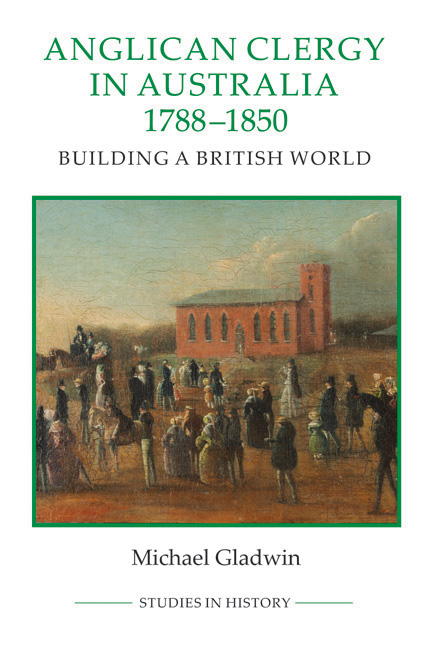Book contents
- Frontmatter
- Dedication
- Contents
- List of illustrations
- Acknowledgements
- Abbreviations
- Map
- Introduction
- PART I SINEWS: FUNDING, RECRUITMENT, BACKGROUNDS AND MOTIVATION, 1788-1850
- 1 Anglican imperial designs? Funding, recruitment and national backgrounds
- 2 Gentility, manners and the ideal colonial clergyman
- 3 Social background, education and motivation
- PART II CLERGYMEN IN COLONIAL AUSTRALIA, 1788-1850
- PART III SCENES OF COLONIAL CLERICAL LIFE: AUSTRALIAN CLERGYMEN AND VOLUNTARISM, 1836-50
- Conclusion
- Bibliography
- Index
1 - Anglican imperial designs? Funding, recruitment and national backgrounds
from PART I - SINEWS: FUNDING, RECRUITMENT, BACKGROUNDS AND MOTIVATION, 1788-1850
Published online by Cambridge University Press: 05 December 2015
- Frontmatter
- Dedication
- Contents
- List of illustrations
- Acknowledgements
- Abbreviations
- Map
- Introduction
- PART I SINEWS: FUNDING, RECRUITMENT, BACKGROUNDS AND MOTIVATION, 1788-1850
- 1 Anglican imperial designs? Funding, recruitment and national backgrounds
- 2 Gentility, manners and the ideal colonial clergyman
- 3 Social background, education and motivation
- PART II CLERGYMEN IN COLONIAL AUSTRALIA, 1788-1850
- PART III SCENES OF COLONIAL CLERICAL LIFE: AUSTRALIAN CLERGYMEN AND VOLUNTARISM, 1836-50
- Conclusion
- Bibliography
- Index
Summary
Somewhat like the long migratory sea journeys undertaken by nineteenth-century Australian clergy, this chapter commences a long chronological and thematic journey that takes us from their metropolitan backgrounds, funding and recruitment through to their colonial and imperial careers. This transnational and imperial context of both Australian and Anglican history is one that historians have only recently begun to reassess. Consequently, the knowledge available about the Australian clergy's funding, recruitment and metropolitan backgrounds and their relation to the colonial and imperial state is largely impressionistic. Analysis of these sinews of the Australian clergy's careers can shed light on at least two related groups of questions. First, to what extent were the clergy's funding and recruitment initiatives linked to formal state networks? Should clergy funding and recruitment be characterised, as some accounts have suggested, as part of an ‘imperial Anglican design’ put forward by élite High Churchmen and representatives of the Second British Empire to cement colonial loyalty to the conservative and aristocratic colonial order which emerged in the wake of the American Revolution? Second, what do the recruitment and national backgrounds of Australian clergy suggest about historians' claims that Anglican clergy and the colonial Church were a quintessentially English clerisy – a genteel, university-educated, English élite charged with ensuring the attachment of colonists to the mother country and empire? These questions form the basis of this chapter. The evidence suggests a far more diverse range of informal networks and religious visions, and a far more complex relationship between clergy, colony and empire, than historians have suggested.
The first ‘Anglican design’ before 1829
Although an imperial ‘Anglican design’ existed in theory from the late eighteenth century onwards, there is little evidence for its existence in reality before 1819. The Australian context bears this out, particularly the limited extent to which the state was either involved or successful in recruiting Anglican clergymen.
- Type
- Chapter
- Information
- Anglican Clergy in Australia, 1788–1850Building a British World, pp. 29 - 56Publisher: Boydell & BrewerPrint publication year: 2015



